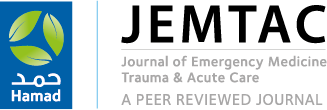-
oa Analysis of dengue surveillance data in Punjab, Pakistan, 2013
- Source: Journal of Emergency Medicine, Trauma and Acute Care, Volume 2016, Issue 2 - International Conference in Emergency Medicine and Public Health-Qatar Proceedings, Oct 2016,
-
- 09 October 2016
Abstract
Introduction: Pakistan has seen repeated outbreaks of the disease over the past decade or so. In 2011 the largest outbreak was seen in Punjab where 20,864 cases were reported. This study was conducted to estimate the disease burden and analyze epidemiological trends using data from the provincial Dengue Surveillance System, Punjab.
Methods: A descriptive analysis of data from January 1 to December 31, 2013, was undertaken. A case of dengue fever was defined as any person with fever from 2–10 days with any three of the following symptoms: headache, retro-orbital pain, myalgia, arthralgia, rash, hemorrhagic manifestation, leucopenia, abdominal pain and restlessness. Population estimates from Federal Bureau of Statistics were used to calculate attack rates.
Results: From January 1 to December 31, 2013, a total of 14,145 suspected cases were reported and 2,662 were confirmed. Out of cases 9,038 (69.3%) were males and 03 deaths were reported with CFR 0.11%. Mean age was 28.5 years (range 1–99 years). About 28 (0.2%) had previous history of dengue fever. Lahore was the most severely hit city (AR = 173/100,000) followed by Rawalpindi (AR = 52/100,000), Kasur (AR = 6.8/100,000) and Faisalabad (AR = 3.1/100,000). Most severely affected age group was 15–49 (AR = 30.8/100,000) followed by 50+ age group (AR = 15.5/100,000). Males were more affected (AR = 26.3/100,000) than females (AR = 11.8/100,000). The cases started increasing in August (1,128), peaking in November with 4,210 cases reported and then declining in December (758).
Conclusion: The analysis showed predominant involvement of adult males. Moreover highest number of cases was reported in the post-monsoon months of September through December. Age, gender specific health education and area specific larvae and vector control activities should be initiated. In 2014 there was significant decrease in dengue cases in Punjab and especially in Lahore where age and area specific targeted activities were conducted and AR was decreased to 21/100000.


